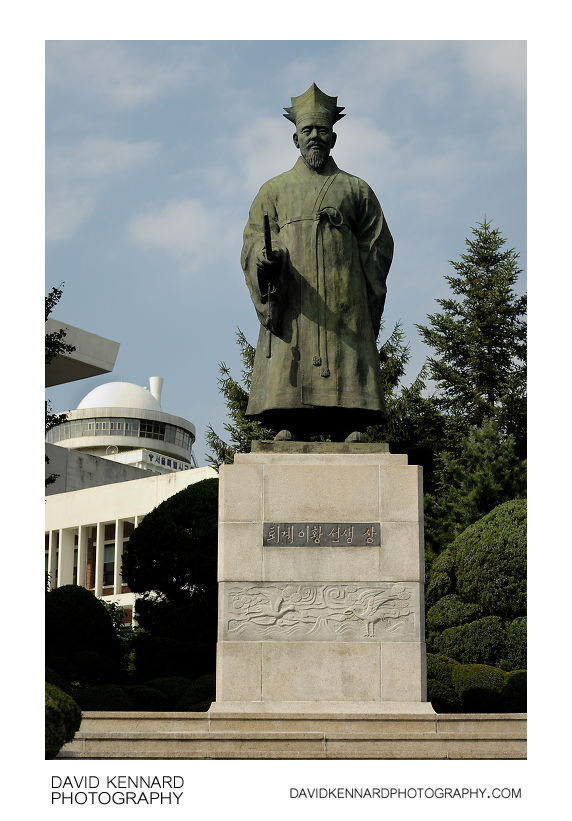Yi Hwang Statue

Description
- Title:
- Yi Hwang Statue
- Caption / Description:
-
A statue of Yi Hwang (이황) near Namsan Library (남산도서관), in Huam-dong (후암동), Yongsan-gu (용산구), Seoul (서울). The statue was errected on October 20, 1970, and stands at a height of 6.5 metres.
Behind the statue can be seen the library, and the domed building behind that is the Seoul Education Research Institute (서울시 교육연구정보원).
Yi Hwang (1501-1570) was a confucian scholar who worked in the government most of his life. He was renowned for his integrity, helping to expose corrupt government officials. During forty years of public life he served four kings: Junjong; Injong; Myeongjong; and Seonjo.
In 1549, at the age of 48, he retired back to his home in Andong (안동시), where he began to build the Dosan Seowon (도산서원), a private Confucian academy. Yi Hwang died before the construction was finished, but his students completed the academy, which opened in 1574.
Yi Hwang authored many books on Confucianism, and also published a "shijo" collection, a short poetic form that was popular with the intellectuals of the Choson period. His interpretation of the "li-chi" dualism also brought him fame in Korea and beyond.
After his death, Yi Hwang was posthumously promoted to the highest ministerial rank. His mortuary tablet is housed in both a Confucian shrine and in the shrine of King Seonjo.
Toegyero (퇴계로), a road in central Seoul is named after Yi Hwang, using his pen name Toegye (퇴계\), and he is depicted on the ₩1000 banknote. The Taekwondo pattern Toi-Gye was also named in honor of Yi Hwang, with the 37 movements of the pattern refering to his birthplace at a latitude of 37° north, and the diagram of the pattern representing scholar.
- Tags / Keywords:
-
- Asia
- 한국
- Hanguk
- 韓國
- Korea
- Seoul Special City
- Seoul Teukbyeolsi
- 서울特別市
- 서울특별시
- Namsan
- 남산
- 南山
- Huam-dong
- Yongsan-gu
- 용산구
- 龍山區
- 후암동
- 厚岩洞
- Gyeongho
- I Hwang
- Lee Hwang
- Munsun
- Toegye
- Yi Hwang
- 文純
- 景浩
- 李滉
- 退溪
- 경호
- 문순
- 이황
- 퇴계
- Seoul Education Research Institute
- 서울시 교육연구정보원
Admin
- Date Original Photo Taken:
- Original File Name:
- _DSC7215a.NEF
- Event:
- Rating:
- ☆
- Date this image added/last updated on website:
- Original File Dimensions:
- 2592px x 3872px
- File Type:
- JPEG
- Color Mode:
- RGB
- Original Image Color Profile:
- Nikon Adobe RGB 4.0.0.3001
Location
- Location Shown:
-
- Sublocation:
- Huam-dong
- City:
- Yongsan-gu
- Province/State:
- Seoul
- Country:
- Korea, Republic Of
- World Region:
- Asia
- Location Created:
-
- Sublocation:
- Huam-dong
- City:
- Yongsan-gu
- Province/State:
- Seoul
- Country:
- Korea, Republic Of
- World Region:
- Asia
- Geo-location:
- 37.552383389444, 126.98192035778 View on map
Rights
- Copyright Status:
- Copyrighted
- Licensing Status:
- Rights Managed
- Available for Editorial Use:
- Yes
- Available for Commercial Use:
- No
- Copyright Notice:
- © 2009 Dave Kennard
Camera Data
- Date Digital Resource was created:
- Shutter speed:
- 1⁄2000 s
- Aperture:
- f/4
- Camera Model:
- Nikon D200
- ISO:
- 200
- Exposure Compensation:
- 0
- Focal Length:
- 50mm
- Focal Length (35mm equiv.):
- 75mm
- Metering Mode:
- Multi-segment
- Flash:
- No Flash
- Exposure Mode:
- Auto
- White Balance:
- Manual
- Light Source:
- Cloudy
- Exposure Program:
- Aperture-priority AE
Additional shooting metadata
- Lens:
- Nikon AF Nikkor 50mm F1.4D
- Filters used:
- Additional Optics used:
- Setup:
- Handheld
Post Processing
- Image Modified:
- Software used:
-
- Nikon Capture NX 2
- Post Processing:
-0.46 negative exposure compensation in Capture NX 2
Highlight Protection slider used in Capture NX 2 to pull back some lost highlight detail
Color Control Point in Capture NX 2 used to brighten statue
Color Control Point in Capture NX 2 used to add contrast to plinth
